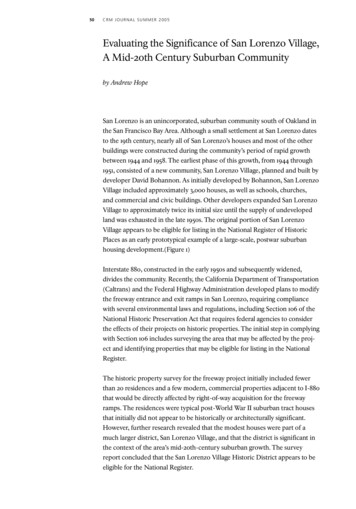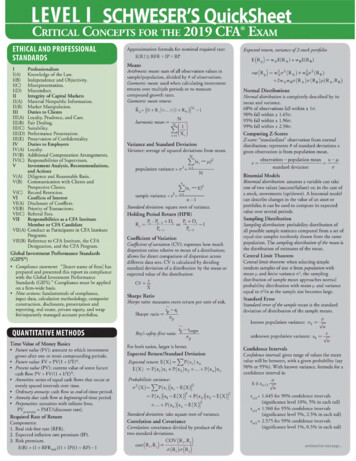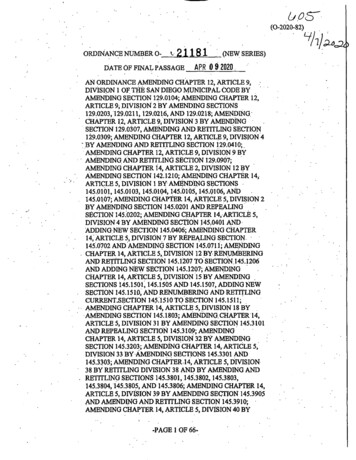
Transcription
50CRM JOURNAL SUMMER 2005Evaluating the Significance of San Lorenzo Village,A Mid-20th Century Suburban Communityby Andrew HopeSan Lorenzo is an unincorporated, suburban community south of Oakland inthe San Francisco Bay Area. Although a small settlement at San Lorenzo datesto the 19th century, nearly all of San Lorenzo’s houses and most of the otherbuildings were constructed during the community’s period of rapid growthbetween 1944 and 1958. The earliest phase of this growth, from 1944 through1951, consisted of a new community, San Lorenzo Village, planned and built bydeveloper David Bohannon. As initially developed by Bohannon, San LorenzoVillage included approximately 3,000 houses, as well as schools, churches,and commercial and civic buildings. Other developers expanded San LorenzoVillage to approximately twice its initial size until the supply of undevelopedland was exhausted in the late 1950s. The original portion of San LorenzoVillage appears to be eligible for listing in the National Register of HistoricPlaces as an early prototypical example of a large-scale, postwar suburbanhousing development.(Figure 1)Interstate 880, constructed in the early 1950s and subsequently widened,divides the community. Recently, the California Department of Transportation(Caltrans) and the Federal Highway Administration developed plans to modifythe freeway entrance and exit ramps in San Lorenzo, requiring compliancewith several environmental laws and regulations, including Section 106 of theNational Historic Preservation Act that requires federal agencies to considerthe effects of their projects on historic properties. The initial step in complyingwith Section 106 includes surveying the area that may be affected by the project and identifying properties that may be eligible for listing in the NationalRegister.The historic property survey for the freeway project initially included fewerthan 20 residences and a few modern, commercial properties adjacent to I-880that would be directly affected by right-of-way acquisition for the freewayramps. The residences were typical post-World War II suburban tract housesthat initially did not appear to be historically or architecturally significant.However, further research revealed that the modest houses were part of amuch larger district, San Lorenzo Village, and that the district is significant inthe context of the area’s mid-20th-century suburban growth. The surveyreport concluded that the San Lorenzo Village Historic District appears to beeligible for the National Register.
51E VA L U AT I N G T H E S I G N I F I C A N C E O F S A N L O R E N Z O V I L L A G EPostwar Suburbs and the Industrialization of Home ConstructionDuring the first half of the 20th century, the housing construction industrycomprised a large number of independent, small-scale builders. As late as 1938,the typical builder constructed no more than 4 single-family houses per year,with only a few builders capable of constructing as many as 10 houses peryear.1 The small scale of production paralleled comparably low demand inmost regions of the United States, due to the difficulty of financing the pur-FIGURE 1Bohannon’s San LorenzoVillage, about half itsultimate size, is shown inthis composite of the 1947San Leandro and HaywardUSGS maps. Additionalhousing was built to thesouth and east in the later1940s and early 1950s.chase of a single-family house. Lending institutions rarely financed more than60 to 70 percent of the purchase price, with mortgages of 5 years or less thatended with a balloon payment.2 These terms prevented much of the middleclass and nearly all of the working class from buying homes, or required manyyears of patient saving prior to making a purchase.The groundwork for altering this state of affairs began with the creation of theFederal Housing Administration (FHA) in 1934. With two million constructionworkers without jobs, FHA initiated a program of mortgage guarantees to spurlenders to make more loans and thereby increase the rate of home construction and ownership. Although lending institutions embraced the program,little headway was made in stimulating the construction industry during the
52CRM JOURNAL SUMMER 2005Depression. The major catalyst for change came with the Serviceman’sReadjustment Act of 1944, commonly referred to as the “GI Bill,” whichincluded provisions for government mortgage guarantees of up to 100 percentof the purchase price. Lending institutions responded to FHA and VeteransAdministration loan guarantees by dramatically reducing the down paymentrequired and providing fixed-rate mortgages for much longer terms than hadpreviously been considered prudent, to as much as 20 years. By the end ofWorld War II, there was a tremendous pent-up demand for housing, due to adecade of economic stagnation preceding the war and the return of millions ofsoldiers to civilian life. With mechanisms for affordable financing in place, thebuilding industry responded to the demand by constructing low-cost housesat a rate never before seen.During the war, the Federal Government became a major customer in thehousing market, constructing two million housing units for defense workersand their families near factories, arsenals, and shipyards.3 In the San FranciscoBay Area, cities such as Oakland, Richmond, and Vallejo saw a huge influx ofdefense industry workers along with government programs to construct housing for them. In fact, the Bay Area was probably the largest recipient of federallyfunded wartime housing construction in the country.4 Because the housinghad to be constructed as quickly as possible, old methods of building onehouse at a time were clearly not sufficient.A small number of builders responded by industrializing the home constructionprocess and standardizing their product. Builders with experience in wartimehousing construction were uniquely positioned to become large-scale housingdevelopers after the war. These men were known as “operative builders,” aterm that referred to those who bought large tracts of land; installed streets,utilities, and other infrastructure; built the houses; and sold the finished housesas part of a new community. Operative builders came to dominate the postwarhousing construction industry by building houses at an unprecedented rateand achieving economies of scale not previously seen in housing construction.Housing developments by operative builders in the decades following thewar were often characterized as assembly lines in which the workers movedrather than the product. The operative builders analyzed the constructionprocess and divided it into discrete tasks assigned to different work crews.Each crew performed its assigned task repeatedly, moving from house tohouse, followed closely by the crew performing the next task. Crews wereorganized by the skill level appropriate to each task. Less experienced carpenters would do the rough wall framing, while the more experienced did moredifficult roof framing, and the most experienced did finish work such as doorand window casings.
53E VA L U AT I N G T H E S I G N I F I C A N C E O F S A N L O R E N Z O V I L L A G EOne of the most important elements of the industrialized building processwas pre-cutting lumber. Typically, a temporary sawmill would be set up at theconstruction site to fabricate the exact quantity and dimensions of lumberneeded for the houses. All of the lumber needed to construct a single housecould then be bundled and delivered to each building lot, eliminating the needfor field cutting. Some of the largest operative builders, including Bohannonand William Levitt (developer of the Levittowns on the East Coast), acquiredstands of timber in northern California, thereby securing a reliable sourceof materials. In addition to lumber, building components from bathtubs todoorknobs were purchased at volume discounts.The industrialized building process originated in California, where it wasapplied to developments of unprecedented size, allowing large numbers ofhouses to be erected with remarkable speed. In particular, the use of temporarysawmills onsite and the bundling of complete sets of lumber and othermaterials for each house came to be known as the “California method.”5By 1949, operative builders had become a major force in the housing market,with just 4 percent of all builders being responsible for 45 percent of newhousing units.6As one of the first of the operative builders, David Bohannon played a leadingrole in the development of mass production techniques. In 1939, Bohannonbegan the construction of Hillsdale, a residential and commercial developmenton the peninsula south of San Francisco. The plan for Hillsdale includedsingle-family houses, apartments, and a shopping center. In the design of thisnew community, Bohannon was influenced by two communities developed inthe 1920s: the Country Club District of Kansas City by J.C. Nichols and HughPotter’s River Oaks community in Houston.7 Each combined housing withshopping centers and recreational facilities.With the suspension of construction at Hillsdale during World War II,Bohannon turned his attention to building houses for defense workers elsewhere in the Bay Area. His first big project was the construction of nearly300 houses near San Jose in 1941, a development that Bohannon completed injust 9 months. This was followed by the construction of more than 500 housesfor shipyard workers in the city of Napa in 1942. Having refined his mass-production techniques with these two projects, Bohannon then built 700 3-bedroom houses in Richmond for workers at the Kaiser shipyards, completing theproject in the remarkable time of just 4 months, between early May and earlySeptember 1943.8Bohannon began the construction of San Lorenzo Village in 1944. While initially housing many defense workers, neither the Federal Government nor thedefense industries were involved in the project as clients. Rather, the projectwas a speculative venture that responded to immediate needs and anticipated
54FIGURE 2This aerial view of a portionof San Lorenzo Village wastaken ca. 1950 as the streettrees were beginning tomature. The buildings at theupper right are part of a latertract by another developer.(Courtesy of the HaywardArea Historical Society)CRM JOURNAL SUMMER 2005the postwar demand for affordable housing. Bohannon acquired 350 acres offarmland in the unincorporated area between San Leandro and Hayward andbuilt nearly 1,500 houses in 1944 and 1945.9 (Figure 2)Bohannon set up a temporary sawmill on the construction site to fabricate2 by 4s and other lumber as needed. The lumber was then assembled into wallpanels with framed openings for doors and windows, and a complete set ofpanels was delivered to each lot. Although factory production of wall panelsis more common in housing construction today, this was an innovation in the1940s. A central mixing plant and reusable forms allowed concrete to bepoured at the rate of 25 house foundations and 1,000 feet of sidewalks andcurbs per day. At the peak of the operation as many as 2,500 workers wereinvolved in the building of the new community.10 Bohannon constructed anaverage of more than 400 houses per year from 1944 through 1951, far beyondthe rate of even the largest builders of the prewar period.Community Planning and DesignOperative builders were also called “community builders,” whose developments went beyond the scale of previous subdivision construction andconstituted entirely new communities. The new housing developments wereoften located well beyond the city limits or the older streetcar suburbs, inunincorporated areas without zoning regulations. As a result, communitybuilders often acted as planners in the absence of government planning,
55FIGURES 3a AND 3bBuilt in 1944-45, these twohouses (upper left and right)have the same planbut different roof forms.E VA L U AT I N G T H E S I G N I F I C A N C E O F S A N L O R E N Z O V I L L A G Eworking out forms that came to be considered standards for developments.While community builders were primarily interested in constructing housesand commercial buildings that would bring a return on their investment, theyalso had to plan for facilities such as schools, churches, parks, libraries, andFIGURE 4fire stations.The corner window lendsthis 1947 house (lower left)a touch of modernity.In addition to planning for a variety of land uses, community builders developed new street layouts, abandoning the rectilinear grids of earlier urbanFIGURE 5The 1948 model house(lower right) featured alarge picture window onthe facade.(All courtesy of the author)and suburban neighborhoods. Curved streets, looping streets, and the shortcul-de-sac were all used extensively in this period. In addition to aestheticconsiderations, the primary motive was to make residential streets safer,especially for children, by reducing the speed and volume of through traffic.The new type of street plan can be seen in San Lorenzo Village, where only 6of the 86 streets in the historic district intersect with Hesperian Boulevard, themain traffic artery through the district. Twenty of the streets are cul-de-sacs,and another 23 are short connector streets with intersections only at theirends. The entire district includes just 124 intersections, substantially less thanwould be found in a development of the same size laid out in a traditional gridpattern. While curved and looping streets were built in suburban housingdevelopments since the designs of Frederick Law Olmsted in the 19th century,they proliferated in the decades following World War II not only in themore expensive neighborhoods, but in tracts of modest houses intended forfirst-time home buyers.(Figures 3a and 3b, Figure 4, and Figure 5)
56CRM JOURNAL SUMMER 2005Mel Scott noted the significance of San Lorenzo Village as a prototypefor new suburban communities in his 1985 book, The San Francisco Bay Area:A Metropolis in Perspective—San Lorenzo Village, begun by the David D. Bohannon Organization in 1944in the area south of San Leandro, was a forerunner of the scores of new “plannedcommunities” of almost identical houses. A whole new town in itself, it housedapproximately five thousand people and had its own shopping center, schools,and recreation facilities. In its planning it was, however, superior to many laterventures in large-scale construction of low-cost houses, because the street systemat least included service roads paralleling a main highway (which unfortunatelysliced through the development) and the interior streets were designed to assureas much safety and convenience as possible.In many of the other speculative developments built in the immediate postwaryears, when returning veterans were taking full advantage of the home-purchasingprovisions of legislation enacted during the war, the street layouts were not socarefully planned, and no sites were set aside for needed schools andplaygrounds.11David Bohannon became the first president of the National Association ofHome Builders, founded in 1941, and was a longtime member of theCommunity Builders Council, founded in 1942 as a subgroup of the UrbanLand Institute.12 The Community Builders Council began publishing theCommunity Builders Handbook in 1947, which codified the planning anddesign principles of the postwar housing developers. Annual issues of theHandbook frequently quoted Bohannon and cited his projects. As a result, thedesign features that appeared in San Lorenzo Village in the late 1940s becamethe design standards for subsequent housing developments nationwide.Significance of San Lorenzo Village’s BuildingsNational Register criteria state that a property may be eligible for listing as anhistoric district if it “represents a significant and distinguishable entity whosecomponents may lack individual distinction.” The houses of San LorenzoVillage are stylistically conservative and conventional in their design and materials, but are representative of their type and period and collectively conveythe immediate postwar era.The industrialization of the building process led to uniformity of the finishedproduct. All of the nearly 1,500 houses constructed in the first phase of theproject utilized the same floor plan, with variety achieved through such techniques as reversing the plan, alternating hipped and gabled roofs, and varyingthe window locations and exterior paint colors. The single-story, 3-bedroomhouses were slightly less than 1,000 square feet, and sold for 6,000.13 One of
57E VA L U AT I N G T H E S I G N I F I C A N C E O F S A N L O R E N Z O V I L L A G Ethe bedrooms had a door leading directly to the outside, so that this roomcould be rented if not needed by the family. Several different designs wereused in the project’s subsequent years, but all of the houses built in a year hadthe same floor plan. Thus, while the house form varied from one neighborhood to the next, all of the houses within a neighborhood were of the samedesign.Distinctive characteristics of the houses include their small size, compactplans, and the absence of large porches, all reflecting the priority given to minimizing construction costs. All of the houses were a single story, with one-cargarages. Exterior materials included stucco and different types of woodsiding, with one-piece, lift-up garage doors. Decorative features were limitedto geometric patterns of wood trim on the garage doors and on panelsbetween the facade windows. The designs provided for direct access to therear yard from the living room or dining area, which, along with the smallfront porches, reflect the period’s emphasis away from the street and publiclife and towards family life and private outdoor space.Although the houses at San Lorenzo are not architecturally distinguished,they collectively form a significant ensemble. The historic character of the district is further enhanced by the fact that all three of the schools, three of thechurches, and the largest of the commercial buildings recognizably date to thesame period as the houses. Two buildings in particular stand out as significantexamples of the period’s architecture: the Lorenzo Theater and the SanLorenzo Community Church. The Lorenzo Theater, a streamline-modernemovie house built in 1947, features a tall sign pylon above the corner marqueethat serves as a landmark for the community. The San Lorenzo CommunityChurch, designed by the architect Bruce Goff during the war for nearby CampParks, incorporates a World War II Quonset Hut for the sanctuary. After thewar, the Quonset Hut was sold to the present congregation, dismantled, andreassembled at its current location.(Figure 6)FIGURE 6The San Lorenzo CommunityChurch was constructed inthe late 1940s from a WorldWar II surplus Quonset Hut.(Courtesy of the author)
58CRM JOURNAL SUMMER 2005IntegrityIn order to be eligible for listing in the National Register of Historic Places, aproperty must possess integrity. This does not mean that a property must be inits original, unaltered state, but it must retain enough of its historic appearanceand original material to convey its historic character and significance. In evaluatingan historic district, the typical approach is to assess the integrity of each buildingand determine whether it is contributing or non-contributing to the district.A building constructed after the district’s period of significance, or that has beenso altered that it no longer conveys its historic character, would be non-contributing. In order for the district as a whole to convey its historical significance, asubstantial majority of individual buildings must be contributing.Almost all of the houses within the proposed San Lorenzo Village HistoricDistrict were constructed between 1944 and 1951, although most have been modified to some degree over the half-century since construction. Other buildingswithin the district, which date to the same period and retain a high degree ofintegrity, include the community center, fire station, and movie theater, as well asthree churches and three schools. Later non-contributing buildings include thelibrary, post office, and three other churches. In addition, most of the existingcommercial buildings date to the 1970s and 1980s, although two of the commercialbuildings date to the mid-1940s. The original Bohannon plan, concentratingcommercial buildings on Hesperian Boulevard, has been maintained.The great majority of the buildings within the proposed San Lorenzo VillageHistoric District are single-family houses. Evaluating their integrity was problematic, because making individual judgments about each of the approximately3,000 houses would have been an enormous undertaking. Instead, a samplingtechnique was used to gather information on a small number of houses, whichwould enable generalizations about the integrity of the district as a whole.While this methodology would probably not be sufficient for a National Registernomination, it was considered sufficient to establish the presence of an eligibledistrict for the purpose of Section 106 compliance.The sample included 10 houses in a row from each of 14 locations selected froma map of the district without prior knowledge of the houses at each location.The 14 locations were evenly distributed throughout throughout the district andincluded houses spanning the entire construction period. Each of the 140 housesin the sample was surveyed, and alterations visible from the front sidewalkswere noted. A majority of the houses have at least one replacement window onthe facade. In most cases, the original window frames have been retained, withnew vinyl-clad or aluminum sash replacing the original wood sash. Forty-two percent of the garage doors in the sample (57 of 135) are replacements. Surprisingly, inonly one house has the garage been converted to additional living space. Twentytwo percent of the houses (31 of 140) have replacement roofs of wood rather than
59FIGURE 7This moderately alteredhouse has replacementwindows, stone veneer onthe facade, and a garageconverted to additionalliving space. (Courtesy ofthe author)FIGURE 8The original form of thissubstantially altered househas been obscured by lateradditions, and no originalmaterial is visible. (Courtesyof the author)E VA L U AT I N G T H E S I G N I F I C A N C E O F S A N L O R E N Z O V I L L A G Easphalt shingles, and one house has a replacement clay tile roof. About onequarter of the houses has a masonry veneer added to the facade, usually as awainscot between grade and the window sills. Of the 36 houses with masonryveneer, 34 are brick and 2 are stone or imitation stone products. Thirteen of thehouses have new wood siding (such as T-111 plywood), which differs in appearance from the original wood siding, and three have aluminum siding. Sevenhouses have been resurfaced in stucco, with a more noticeable texture than thesmooth finish of the unaltered stucco houses. Thirteen houses have additionson the front, and two others have second story additions at the rear. The additions range from an enclosed front porch to more substantial enlargements.Following the survey, the 140 houses in the sample were sorted into 4 categories: unaltered, slightly altered, moderately altered, and substantially altered.A house might be considered slightly altered if, for example, the only changeswere the addition of a brick wainscot to the facade and a new garage door.Moderately altered houses could still be recognized as dating to the era oftheir original construction, but have had several minor alterations, possiblycombined with a more substantial alteration such as the enclosure of the frontporch. Substantially altered houses show extensive changes to the fenestration,second-story additions, etc. Generally, substantially altered houses could nolonger be recognized as dating to the era of their original construction. (Figure7 and Figure 8) Nineteen of the houses in the sample (13 percent) appeared tobe unaltered, and another 92 houses (66 percent) only slightly altered, 14 houses (10 percent) fell into the “moderately altered” category, and the remaining15 houses (11 percent) exhibited substantial alterations.Based on sampling results, the dividing line between contributing and noncontributing buildings falls somewhere within the “moderately altered” group,with all of the “substantially altered” houses and most of the “moderatelyaltered” houses being non-contributing. At least 80 percent of the houses in thedistrict appear to be contributing, a more than sufficient proportion for the district as a whole to convey its historical significance. In addition to the sampling,a windshield survey of the entire district appeared to confirm that the 140 housessurveyed in the integrity sample were representative of the whole district.
60CRM JOURNAL SUMMER 2005ConclusionThe Historic Architecture Survey Report for the San Lorenzo Village HistoricDistrict was transmitted to the California State Historic Preservation Office(SHPO) in 2002, with a request for concurrence regarding eligibility of thedistrict and other historic properties. The report concluded that San LorenzoVillage is significant as one of the earliest of the Bay Area’s postwar plannedcommunities, and for its pioneering role in the application of mass-productiontechniques to house construction. The district is also significant for its association with David Bohannon, one of the most influential community builders ofthe postwar period. The district’s houses and other buildings exhibit the distinctive character of their type and period, and the community as a whole conveys astrong sense of the postwar era, in spite of alterations to individual houses.Because of the size of the district and its unusual nature, SHPO staff requesteda tour with Caltrans staff to visually confirm whether the district conveys itshistoric significance and possesses sufficient integrity for National Register listing. Discussions during and after the tour revealed that SHPO staff had a morenegative view of the district’s integrity, and there was no consensus on theNational Register eligibility of the district. The SHPO staff’s more skepticalview of the proposed district was due in part to the high proportion of housesthat exhibited at least some alterations, and in part to a higher threshold for thedegree of alteration that an individual house could exhibit and still be considered contributing to the district. Particular objection was made to the introduction of materials, such as brick, that were not part of the development’s originalmaterials palette.Subsequent to the site tour with the SHPO staff, a reduction in the scope of thefreeway project eliminated the need to acquire additional right-of-way adjacentto the freeway. The redesigned project had no potential to affect the proposedhistoric district, and therefore no formal response from the SHPO was neededor received on the question of the district’s eligibility.The tour revealed that the integrity of the proposed historic district had diminished noticeably in the two years since the survey effort began. The integrity ofthe district will undoubtedly continue to diminish as property owners continueto alter their houses. The San Lorenzo Village Homes Association, whichenforces deed covenants and has authority over exterior alterations to thehouses, prohibited the construction of second-story additions for more than40 years. However, amid growing concerns that San Lorenzo was becoming acommunity of retirees, the homeowners’ association lifted the prohibitionabout 15 years ago in an attempt to attract more young families with children.14More second-story additions are likely, as the original houses are consideredtoo small by today’s standards.
61E VA L U AT I N G T H E S I G N I F I C A N C E O F S A N L O R E N Z O V I L L A G EWhile alterations to the houses are inevitable, the significance of San LorenzoVillage lies as much in its overall planning as in the architectural qualitiesof the individual buildings.15 The distinctive character of the district derives inpart from its street layout and the planning for schools, churches, and othercommunity facilities. Physical features that distinguish San Lorenzo Villagefrom later neighboring developments include the relatively narrow streets withmountable curbs, and the now-mature trees. Later subdivisions in the area generally have wider, straighter streets with square curbs, and a substantially lowerinvestment in landscaping.As more postwar housing tracts are considered for National Register eligibilityand listing, the issue of assessing their integrity will become more urgent.Lacking consensus about the appropriate level of integrity for this type ofproperty, these historically important properties may remain unprotected andunderrepresented in the National Register of Historic Places.Andrew Hope is an associate environmental planner (architectural history)with the California Department of Transportation in Sacramento. He can bereached at andrew hope@dot.ca.gov.Notes1. Marc A. Weiss, The Rise of the Community Builders (New York, NY: Columbia UniversityPress, 1987), 38.2. Ned Eichler, The Merchant Builders (Cambridge, MA: MIT Press, 1982), xvi.3. Gwendolyn Wright, Building the American Dream: A Social History of Housing in America(Cambridge, MA: MIT Press, 1981), 242.4. Sherman Maisel, Housebuilding in Transition (Berkeley: University of California Press, 1953), 12.5. “Big Dave Bohannon: Operative Builder by the California Method,” Fortune (April 1946): 145.6. Weiss, 161.7. “Big Dave Bohannon,” 146.8. “Big Dave Bohannon,” 190.9. “Big Dave Bohannon,” 190.10. “Big Dave Bohannon,” 145.11. Mel Scott, The San Francisco Bay Area: A Metropolis in Perspective (Berkeley: University ofCalifornia Press, 1985), 273.12. “Big Dave Bohannon,” 146.13. “Big Dave Bohannon,” 145, 194.14. Doris Marciel, San Lorenzo resident and local historian, personal communication, January18, 2005.15. Ric
50 CRM JOURNAL SUMMER 2005 San Lorenzo is an unincorporated, suburban communitysouth ofOakland in . small-scale builders. As late as 1938, . first-time home buyers.(Figures 3a and 3b, Figure 4, and Figure 5) FIGURES 3a AND 3b Built in 1944-45, these two houses (upper left and right) have the same plan










